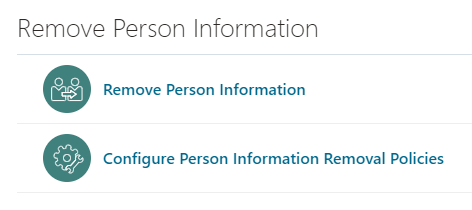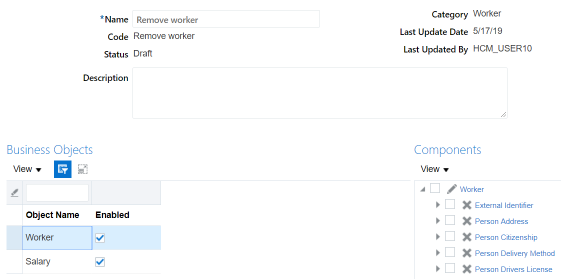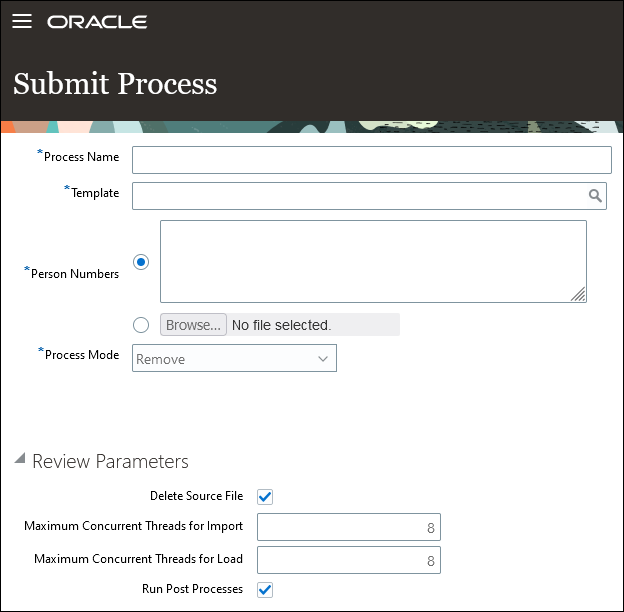Remove Person Information
You can remove data related to terminated employees or canceled work relationships from the Oracle HCM Cloud. This solution is available in the Data Exchange work area with its own dedicated tasks.
Additionally using the remove person information feature you can:
-
Purge data from HCM Data Loader staging tables for terminated employees.
-
Perform staggered disposal of data for a terminated employee. For example, you can now purge Global HR data first while retaining the payroll data for a longer time and purge payroll data at a later date in the future using the same person number reference.
-
Delete workers with canceled work relationships (rather than just terminated).
To remove a person information, you need to have access to the following pages:

-
Configure Person Information Removal Policies: Configure the business objects and its components that you want to remove and mask mandatory attributes. To access this page, you must have the Configure Person Information Removal Policies privilege (HRC_CONFIGURE_PERSON_INFO_REMOVAL_POLICIES_PRIV).
-
Remove Person Information: You can remove person information for specified people from this page. When you submit the person information removal process, the data is removed as per the configuration defined in the associated person information removal policy.
To grant access to a user for removing person information:
-
On the Create Role page of the Security Console, create a job role.
-
On the Function Security Policy page (Navigator > Security Console > Roles > Create Role), add Configure Person Information Removal Policies (HRC_CONFIGURE_PERSON_INFO_REMOVAL_POLICIES_PRIV) privilege to the role.
-
On the Role Hierarchy page (Navigator > Security Console > Roles > Create Role, add Remove Person Information (ORA_HRC_REMOVE_PERSON_INFORMATION) role membership to access both Report and Remove modes. Add Generate Remove Person Information (ORA_HRC_GENERATE_REMOVE_PERSON_INFORMATION_FILE) role membership to access Report mode alone.
-
On the Data Roles and Security Profiles page (Navigator > My Client > Workforce Structures > Data Roles and Security Profiles), create a data role for the job role that you created.
Note: Remove Person Information security is person-based therefore, to restrict access for removing person information, you can create a security profile on the Person Security Profiles page (Navigator > My Client > Workforce Structures > Security Profiles) and add it to the data role. If you want users to access and remove all person records, use View All People security profile. -
Add the data role to appropriate users.
-
In addition, to execute the process, you also need these roles:
-
HCM Data Loader is used to perform the data removal. You need HRC_LOAD_HCM_DATA_PRIV (Load HCM Data) privileges to do so.
-
For UCM upload or download, you need HCM_DATALOADER_IMPORT_RWD to upload data for Human Capital Management file based Import, HCM_DATALOADER_EXPORT_RWD to download data from Human Capital Management file based Export, and 'Transfer HCM File from UCM and import into stage' (HRC_TRANSFER_HCM_FILE_AND_IMPORT_PRIV).
How Person Removal Policies Work
Before you submit the Remove Person Information process, you must configure a policy that defines which business objects will have data removed or obfuscated. The Configure Person Information Removal Policies user interface includes business objects that are supported by this feature. You will see that records you can delete are highlighted and can only be selected for deletion in the policy configuration. Records that you can't delete, you can configure at the attribute level, and identify the attributes that should be set to null or how an attribute should be masked (for attributes that cannot be set to NULL). Here are the attributes displayed on the page:
-
CATEGORY: The Business Object the template was created for (for example: Worker).
-
STATUS: The status of the template (Draft, Active, Inactive). Only a template in Draft status can be modified. An active template can be only processed. An inactive template can't be processed nor can it be modified.
-
CREATED BY: The user who created the template.
-
LAST UPDATE DATE: The last date and time the template was updated.
To create templates and configure removal policies:
-
Click Create to open the Create Template window. Required fields are:
-
NAME: The name of the template.
-
CODE: The template code, defaults to the name of the template.
-
CATEGORY: The Business Object the template is created for: the options are Worker or Candidate.
-
DESCRIPTION (optional): The user can also enter a description.
-
-
Select one or more Business Objects.
-
Under the Business Objects section, search for a specific business object and select objects to process. The Components section, select the child objects under the selected business object.
Note:- When you select a component with associated dependent objects, you're recommended to select the dependent objects to avoid orphan data.

-
Use the Rules tab to configure policies. Most objects are configured for deletion, so no specific rules are needed for those objects. You can configure rules for objects if they contain attributes that can only be obfuscated and cannot be deleted. If you specify a generic value to include in a field, you can use any value except null. For example, the Person Last Name can't be deleted, so it needs to be replaced by a static value. ZZZZZ is the default. The Person Last Name will be replaced by this static value appended by an internal identifier, to maintain the uniqueness of this attribute and thus the data integrity. Notice the Search boxes for Attribute Names and Description.

Remove Person Information
When you submit the Remove Person Information process, you will need to identify the population of workers to discard and select the data removal policy to use. The policy determines which business objects are removed and how. Surrogate IDs are used to identify the records to discard, but the Person Information Removal framework will also include any other attributes that are mandatory when disposing data, such as ActionCode.
Points to consider:
-
Ensure that the process is run on terminated workers only, with a termination date in the past. Deleted data can't be recovered so proceed with caution.
-
The process details are stored (for example, templates and person number) but the worker data as per the template definition is removed.
-
A user can delete data for a person if they can access the person's data. For example, a user must have the following privileges to dispose Person Email and Person Phone data:
- Manage Person Phone - PER_MANAGE_PERSON_PHONES_DATA
- Manage Person Email - PER_MANAGE_PERSON_EMAIL_DATA
To start the Remove Person Information process, perform these steps:
-
Click Submit Process
-
Enter a process name and select a template from the searchable list.
-
Enter the Person Numbers, separated by commas, which are to be deleted or obfuscated.
Note: You can also upload a file containing a list of Person Numbers separated by commas. -
Select a Process Mode: Report or Remove.
Note: The Remove mode is an ESS process that extracts key information for the records to be deleted or masked and generates an HCM Data Loader business object .dat file for each business object in the selected policy. The generated .dat files are zipped together and uploaded with HCM Data Loader. The Report mode only produces the .dat file that is zipped and can be downloaded locally for review. HCM Data Loader does not process the .dat file and no information is deleted or obfuscated when run in Report mode.
- In the Remove mode, you can set the following
additional runtime parameters to override the default HCM Data Loader values in
the Review Parameters section:
- Delete Source File: Deletes the data set file from UCM.
- Maximum Concurrent Threads for Import: Maximum number of concurrent threads to assign to the import process. The default is defined by the Maximum Concurrent Threads for Import parameter in the Configure HCM Data Loader task.
- Maximum Concurrent Threads for Load: Maximum number of concurrent threads to assign to the load process. The default is defined by the Maximum Concurrent Threads for Load parameter in the Configure HCM Data Loader task.
- Run Post Processes: Submits the business object post processes and the Oracle Search Bulk Ingestion process.
- In the Report mode, you can only set the Run Post Processes review parameter.
Note: If you deselect the Run Post Processes parameter while clicking Submit, then a warning message displayed to indicate that post processes, including Oracle Search Bulk Ingestion, will not be executed for this Data Disposal process. - In the Remove mode, you can set the following
additional runtime parameters to override the default HCM Data Loader values in
the Review Parameters section:
Here's what you will see on the page after you submit the process:
-
STATUS: Success or Error.
-
PROCESS MODE: Remove mode or Report mode.
-
SUBMITTED BY: The user who submitted the process.
-
SUBMISSION DATE: The date the process was submitted.
You can also use the View Process Details icon to view different stages of the Person Information Removal process, as well as the corresponding log files:
-
The log file details all steps taken in the process and the number of workers processed (for example, No of Employees Matching the Termination Criteria.
-
If the Report mode was selected, you can use the Download Data File icon to download the .zip file containing the .dat file, although this file can't be used in another HDL process.
When to Create Templates for Effective Data Disposal
You must create new templates to prevent components from being missed out or to avoid errors during data disposal.
- Changes to Business Object Components or Attributes:
- Adding a new Business Object Component. For example, adding a new business object component Person Phone in the Worker object.
- Modifying components in a business object hierarchy. For example, changing the entity type from DELETE to UPDATE.
- Deleting an existing component from the business object hierarchy. For example, deleting the Person Email component of the Worker object.
- Adding a new Attribute in a Business Object Component. For example, adding a new attribute Person First Name to the list of Person Name component of the Worker object.
- Changing the default value for an existing attribute. For example, updating the default value of Person First Name from ZZZZZ to WWWW.
- Changes in Flexfield structure:
- Adding a new Mandatory Global Segments. For example, adding a new Global Mandatory Segment for a worker descriptive flexfield in the Worker business object hierarchy. This would cause the existing templates in Worker to fail due to missing mandatory segments. You must create a new template to include the latest flexfield definition.
- Supporting new flexfields for a business-object component in a new release.
How to Enable Access to the Data Disposal Folder for Reporting
|
Functional Privilege Name |
Functional Privilege Code |
|---|---|
|
Report Person Information Removal Processes |
|
|
Functional Privilege Name |
Functional Privilege Code |
|---|---|
|
Report Person Information Removal Templates |
|